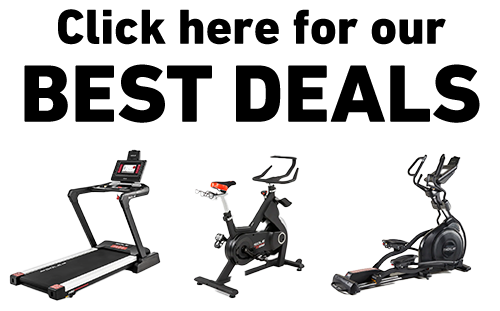Key Takeaways
- Walking 2 miles on a treadmill typically takes between 26–60 minutes, depending on your walking speed, with most people completing it in 30–40 minutes at a moderate pace.
- Incline settings significantly impact your walking time; a 5% incline can make your 2-mile walk feel equivalent to walking 2.5 miles on flat ground.
- Beginners should start at 2.0–3.0 mph, while experienced walkers can maintain 4.0–4.5 mph for effective cardio workouts.
- Treadmill walking is generally faster than outdoor walking due to consistent terrain and the absence of weather factors.
- SOLE treadmills’ commercial-grade construction, Cushion Flex impact reduction technology, and precise motor control ensure every step on the treadmill is comfortable and consistent.
What You Need to Know About Walking 2 Miles on a Treadmill
The exact time it takes to walk 2 miles depends primarily on your walking speed. The mathematical calculation is straightforward: Time = Distance ÷ Speed. At 3.0 mph, which is a comfortable moderate pace for many people, walking 2 miles takes 40 minutes (2 ÷ 3 = 0.67 hours or 40 minutes). If you increase your pace to 4.0 mph, you'll complete the same distance in just 30 minutes.
Why Pace Varies Between People
Walking pace varies significantly between individuals based on several physiological and personal factors. Height plays a major role; taller individuals typically have longer strides, allowing them to cover more ground with each step. Age and fitness level are both important determinants of walking speed.
Most adults reach their peak walking efficiency in their 20s and 30s, with gradual decreases in average speed as they age. However, regular exercise can significantly slow this decline. Your cardiovascular fitness, muscle strength, and joint mobility all contribute to how fast you can comfortably walk and sustain that pace.
Treadmill vs. Outdoor Walking Time Differences
Walking 2 miles on a treadmill typically takes less time than walking the same distance outdoors. This efficiency occurs because treadmills provide a consistent, controlled environment without hills, wind resistance, terrain changes, or obstacles that might slow you down outdoors.
|
Award-Winning Commercial-Grade Treadmills for Your Home
Why Choose SOLE: ✓ Commercial-grade steel frames with up to 4.0 HP motors 30-Day Money-Back Guarantee: Love it or return it, no questions asked. |
Walking Speed Breakdown: From Beginner to Power Walker

Each speed range offers different benefits and suits different fitness levels, from total beginners to experienced power walkers seeking maximum cardiovascular challenge.
Slow Pace (2.0–3.0 mph): 40–60 Minutes
Walking at 2.0–3.0 mph provides an excellent starting point for beginners, older adults, or those recovering from injury. At these speeds, a 2-mile walk takes 40–60 minutes, offering accessible cardiovascular exercise while minimizing joint impact.
Even at slower speeds, you'll burn approximately 150–200 calories during a 2-mile walk, making it an effective component of weight management programs.
Moderate Pace (3.0–4.0 mph): 30–40 Minutes
The moderate pace range represents a comfortable walking speed for most reasonably fit adults.
At these speeds, you'll complete 2 miles in 30–40 minutes while elevating your heart rate to approximately 50–65% of maximum, which places you in the moderate-intensity exercise zone.
This pace feels purposeful without being strenuous; you should be able to maintain conversation while definitely feeling like you're exercising.
Brisk Pace (4.0–4.5 mph): 26–30 Minutes
Walking at 4.0–4.5 mph constitutes brisk walking and requires good cardiovascular fitness. At this pace, you'll complete 2 miles in 26–30 minutes while working at approximately 65–75% of maximum heart rate.
Breathing becomes noticeably heavier, and conversation becomes more difficult, though still possible in shorter phrases.
Power Walking (4.5+ mph): Under 26 Minutes
Power walking at 4.5+ mph represents the highest walking intensity before transitioning to jogging. You'll complete 2 miles in under 26 minutes, with experienced power walkers potentially finishing in 22–24 minutes at 5.0 mph.
This pace requires significant cardiovascular fitness and proper technique, including exaggerated arm swing, engaged core, and purposeful heel-to-toe strikes.
Factors That Affect Your 2-Mile Treadmill Time

Multiple variables beyond speed influence your walking experience and completion time, from fitness level and incline settings to treadmill quality and walking technique.
While speed is the primary factor determining completion time, several other variables significantly impact your walking experience and final time.
Walking Speed and Fitness Level
Your baseline fitness level directly influences the pace you can comfortably maintain during a 2-mile treadmill session. Beginners might find that 2.5–3.0 mph represents their maximum sustainable pace, while those with higher cardiovascular fitness may comfortably walk at 4.0 mph or faster.
Muscle strength, particularly in your legs and core, affects walking efficiency and endurance. Stronger muscles support better posture and more powerful strides, which allows you to maintain faster speeds for longer periods.
Incline Settings
The incline settings dramatically impact the difficulty and calorie burn of your 2-mile walk. A 1% incline simulates outdoor walking conditions, while inclines of 2–5% represent gentle hills. At a 5% incline, your 2-mile walk can feel equivalent to walking 2.5 miles on flat ground due to the increased effort required.
Higher inclines of 8–12% simulate challenging uphill terrain and significantly increase workout intensity. Walking at 3.0 mph on a 10% incline burns approximately 40% more calories than walking at the same speed on a flat surface.
Age and Physical Condition
As earlier mentioned, age naturally affects walking pace and endurance for most people. Average walking speed tends to decline by approximately 0.2–0.3% per year after age 60, though this varies widely based on activity level.
Physical conditions, including joint problems, respiratory limitations, or balance issues, can also impact your treadmill pace. Those managing arthritis or recovering from injuries might need slower speeds, but can often compensate by extending workout duration.
Treadmill Quality and Calibration
The accuracy of your 2-mile walking time depends partly on treadmill quality and calibration. Commercial-grade treadmills generally offer more precise speed settings and distance measurements than budget home models. Some treadmills may display speeds that are slightly faster or slower than actual belt movement.
Belt length also influences walking comfort and potentially your pace. Treadmills with longer decks (55–60 inches) accommodate natural stride variations better than compact models, making maintaining faster walking speeds more comfortable.
Perfect Your 2-Mile Walks with SOLE's Premium Treadmills

SOLE's commercial-grade treadmills provide everything needed for consistent, comfortable walking workouts.
The F63 treadmill has a reliable 3.0 HP motor power that maintains steady speeds no matter if you're walking at 2.5 mph or pushing 4.5 mph for power walking sessions.
For those serious about daily walking, the F80 treadmill features the Cushion Flex Whisper Deck that reduces impact by 40%. This is essential for protecting joints during regular 2-mile sessions. The powerful 3.25 HP motor handles any walking speed smoothly, while the 10.1" touchscreen keeps you motivated with entertainment options and workout tracking.
The F85 and F89 models take walking comfort further with advanced cushioning systems and larger running surfaces (20" x 60") that accommodate natural stride variations during longer walks. The SOLE TT8 treadmills with weight capacities up to 400 pounds and whisper-quiet operation support serious walking routines for years.
Every SOLE treadmill includes the free SOLE+ App with guided walking workouts, progress tracking, and no subscription fees. The lifetime warranty on frame and motor shows our confidence in our construction quality.
Ready to invest in treadmill walking that delivers results? Check out SOLE treadmills today!
Frequently Asked Questions (FAQs)
Is walking 2 miles on a treadmill enough exercise?
Walking 2 miles on a treadmill constitutes sufficient exercise for many health goals when performed regularly. This distance aligns with health authorities' recommendations for 150+ minutes of moderate-intensity activity weekly. For general health maintenance, walking 2 miles daily provides significant benefits, including improved cardiovascular health, better mood, and reduced chronic disease risk.
How can I make walking 2 miles on a treadmill more challenging?
Adding incline is the most effective method. Even a modest 3–5% grade significantly increases workout intensity without requiring faster speeds. Interval training, alternating between faster walking and recovery periods, improves cardiovascular fitness efficiently. Consider incorporating weighted vests (starting with 5–10 pounds) or reducing handrail support to increase calorie burn.
Should I hold onto the treadmill rails while walking?
Generally, avoid holding treadmill rails during normal walking unless experiencing balance issues. Gripping rails reduces calorie expenditure by 20–25%, diminishes core engagement, and creates unnatural body positioning. Focus on maintaining good posture with your shoulders back, core engaged, and arms swinging naturally.
How often should I walk 2 miles on a treadmill to see results?
Aim to walk 2 miles on the treadmill at least 3–5 times weekly for noticeable improvements. Consistency is crucial; regular, moderate exercise produces better long-term results than occasional, intense sessions. Most people see measurable cardiovascular fitness improvements within 2–3 weeks of consistent training.
What SOLE treadmill features help optimize 2-mile walking workouts?
SOLE treadmills offer several features that enhance 2-mile walking sessions. The Cushion Flex Whisper Deck technology available on F80, F85, F89, and TT8 models reduces impact by 40%, crucial for comfortable longer walks. Powerful motors up to 4.0 HP maintain consistent belt speed throughout your workout, while precise speed controls allow gradual pace adjustments.







Leave a comment
This site is protected by hCaptcha and the hCaptcha Privacy Policy and Terms of Service apply.